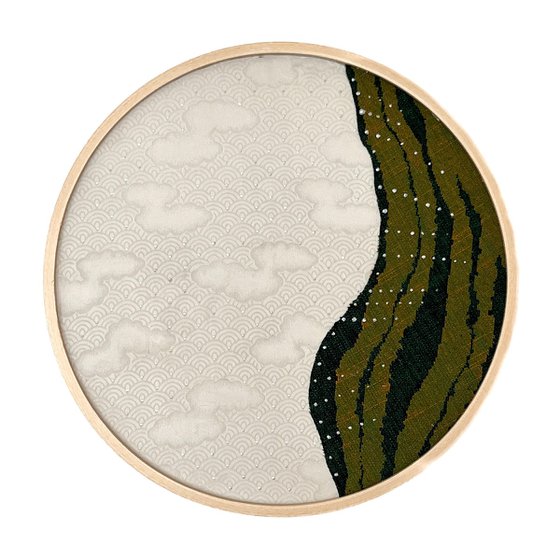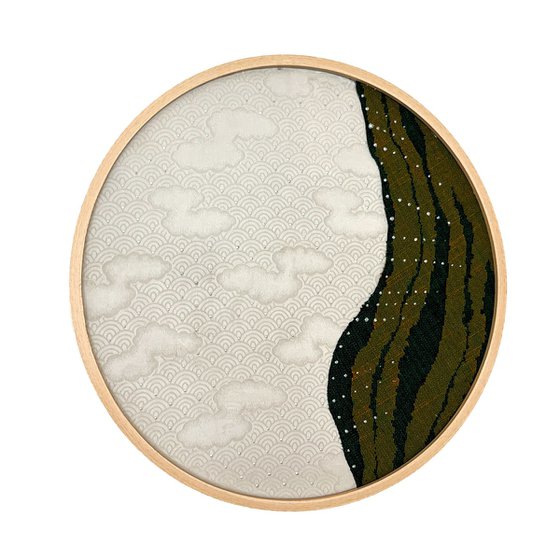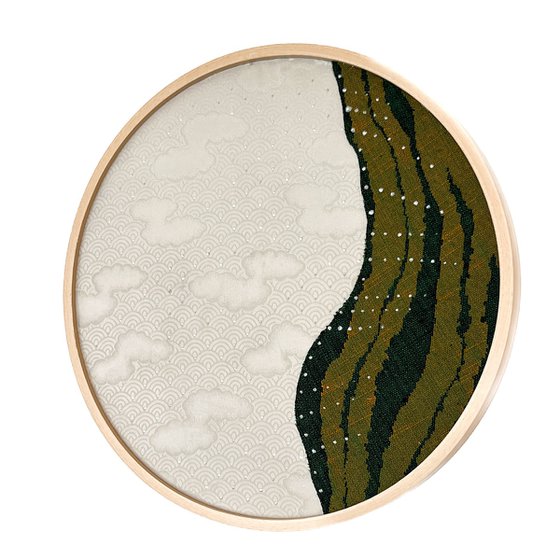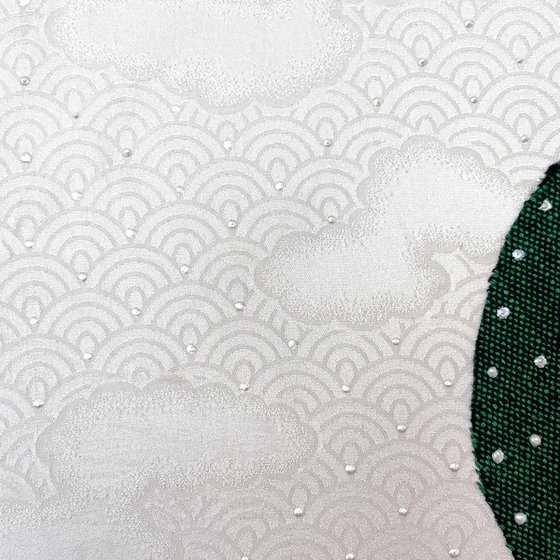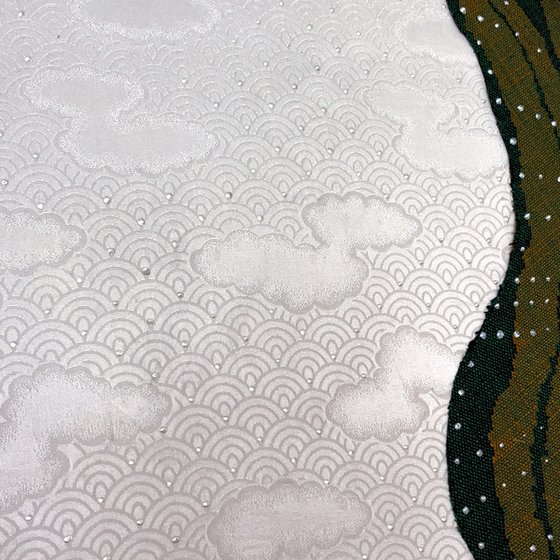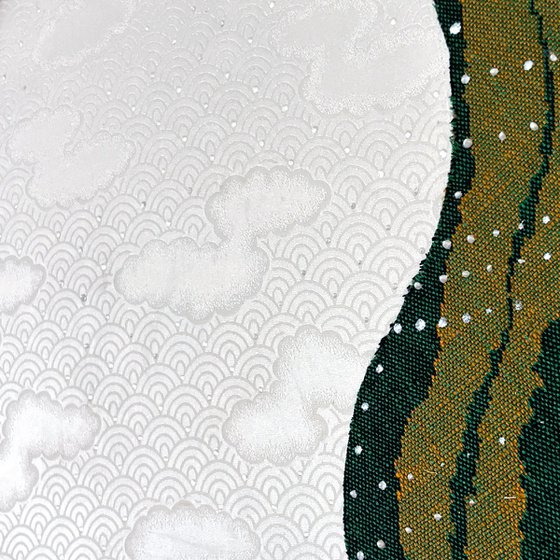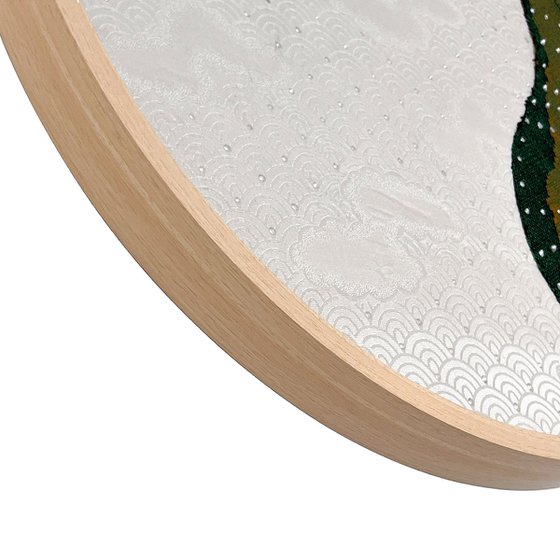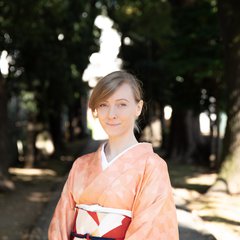Main Navigation
Original artwork description:
[Story behind the work]
This artwork uses two pieces - white vintage kimono fabric for sea and green vintage obi (sash for kimono) fabric for seashore, to depict a sealine from bird view.
The foam left from the waves on the seashore is created by acrylic painting.
[Period]
The artwork uses obi and kimono textiles both from Showa era, around 1960ies.
[Meaning of patterns and colors]
In Japanese culture, the sea and shore represent the eternal meeting of movement and stillness - a dialogue between the vast and the grounded.
The sea embodies depth, mystery, and the boundless flow of time, while the shore signifies presence, return, and human connection to the natural world.
Ancient Japanese poetry often captures this encounter: waves that come and go like thoughts or memories, leaving quiet traces on the sand. The shifting boundary between sea and land reflects the Buddhist sense of impermanence - that nothing is fixed, and all things are in gentle motion.
In kimono textiles, the sea and shore motifs express both serenity and vitality. The rhythmic curves of waves and the delicate patterns of foam speak of life’s continuity, of moments that vanish yet remain within the heart.
Together, they form a timeless metaphor for harmony - between strength and softness, movement and pause, the eternal and the fleeting.
[About the Material]
The background fabric of the "sea" has woven ground pattern - "jimon"地紋, that gives it shimmery glow depending on the angle that light hits the fabric surface.
Materials used:
silk (outside-layer), wood
Tags:
#japan #green #upcycled #textile art #kimono artSealine ~Transitions~ (2024) Collage
by Lena Okamoto
£833.1
- Collage on Other
- One of a kind artwork
- Size: 50 x 50 x 4cm (framed)
- Framed and ready to hang
- Signed certificate of authenticity
- Style: Collage
- Subject: Abstract and non-figurative
Loading
Original artwork description
[Story behind the work]
This artwork uses two pieces - white vintage kimono fabric for sea and green vintage obi (sash for kimono) fabric for seashore, to depict a sealine from bird view.
The foam left from the waves on the seashore is created by acrylic painting.
[Period]
The artwork uses obi and kimono textiles both from Showa era, around 1960ies.
[Meaning of patterns and colors]
In Japanese culture, the sea and shore represent the eternal meeting of movement and stillness - a dialogue between the vast and the grounded.
The sea embodies depth, mystery, and the boundless flow of time, while the shore signifies presence, return, and human connection to the natural world.
Ancient Japanese poetry often captures this encounter: waves that come and go like thoughts or memories, leaving quiet traces on the sand. The shifting boundary between sea and land reflects the Buddhist sense of impermanence - that nothing is fixed, and all things are in gentle motion.
In kimono textiles, the sea and shore motifs express both serenity and vitality. The rhythmic curves of waves and the delicate patterns of foam speak of life’s continuity, of moments that vanish yet remain within the heart.
Together, they form a timeless metaphor for harmony - between strength and softness, movement and pause, the eternal and the fleeting.
[About the Material]
The background fabric of the "sea" has woven ground pattern - "jimon"地紋, that gives it shimmery glow depending on the angle that light hits the fabric surface.
Materials used:
silk (outside-layer), wood
Tags:
#japan #green #upcycled #textile art #kimono art14 day money back guaranteeLearn more
